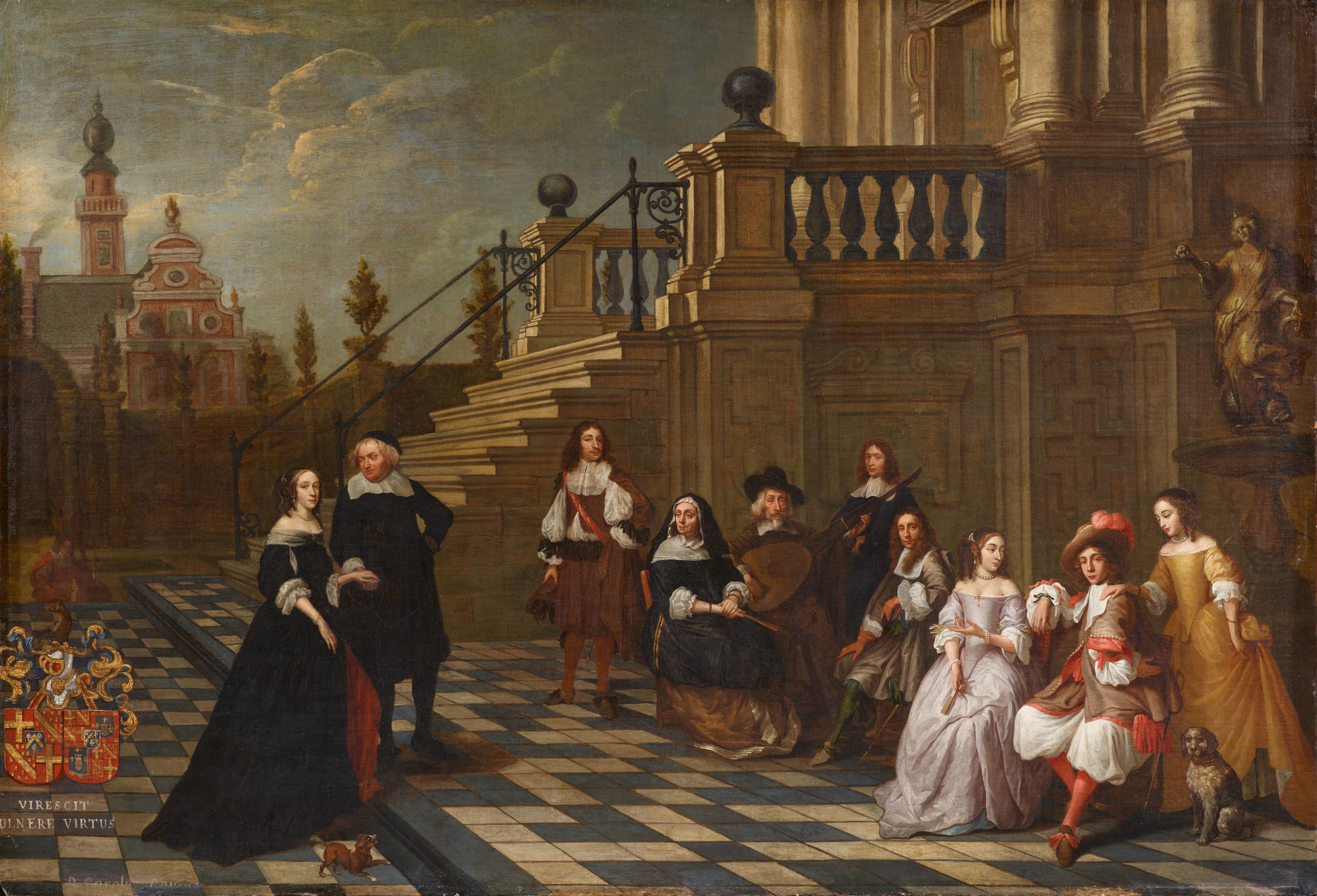Gillis van Tilborgh the Younger, circle of
Noble Family at a Lute Concert in the Courtyard of a Flemish Palace
Oil on canvas (relined). 137 x 200 cm.
With the arms of alliance of the Biseau family in the lower left, thereunder the motto "virescit vulnere virtus" and an indistinct inscription "Carolus (...)"..
This family portrait set against the backdrop of a Flemish Baroque palace presumably shows members of the noble de Biseau de Beusdael family from Mons. They can be identified because of the inclusion of their arms of alliance on the bottom left of the painting. Their motto "virescit vulnere virtus" (courage sprouts through wounds) is inscribed under the coat-of-arms. The important union that took place in this family is the subject of this wedding picture, and is reflected in its rich symbolism. Judging by the coat-of-arms, the couple may have been Charles-Lambert de Biseau de Beusdael (circa 1650-1725) and Marie-Marg De Molina (1660-1700). The scene takes place before the facade of the “Salle Saint-Georges”, a baroque gabled house next to what is now the town hall on the “Grande Place” of Mons. The tower with its bulbous spire is presumably a schematic representation of the belfry.
The family has gathered in front of their palace on a wide, tiled terrace for a concert. They pose in front of an imposing, majestic staircase, which symbolically illustrates the “rising” fame of the alliance. The key to deciphering the painting is the couple on the left edge of the picture. A young woman is being led by the hand over a step towards the company in the upper part of the terrace by a man. She is obviously the fiancée being “introduced” into the family. The seated older lady, presumably the future mother-in-law, greets the fiancée by making eye contact. Her husband is shown playing the theorbo, a symbol of family harmony. On the outer right side, the young groom poses in elegant clothing with a sword at his waist, attributes of his high social position. He is flanked by two young women - probably his sisters - one of whom points towards the fiancée. The statue of the ancient goddess Ceres behind the groom promises fertility and prosperity for the union, while the two dogs on either side of the two protagonists represent loyalty.
The question of who painted this impressive family portrait has not yet been sufficiently clarified. The size of the painting alone indicates that it must have been an important commission. References to Antwerp portraiture, particularly to the work of Gonzales Coques, are obvious. In terms of composition and motifs, comparisons can be made to Coque's work "Portrait of a Family on the Estrade" dated 1660 (see illustration in M. Lisken-Pruss: Gonzales Coques, 1614-1684, Little Van Dyck, Turnhout 2013, cat. 33). Stylistically there are references to his successor Gillis van Tilborch (Brussels 1625 - 1678), who was registered as a master in the Guild of St. Luke in Brussels in 1654. Drs. Claire van den Donck from the RKD, The Hague assumes that the painting could have been created in Gillis van Tilborch's studio (written communication dated February 2nd, 2015).
Numerous infrared images of the painting were taken in 2015 and are available to be viewed upon request.
Provenance
Belgian private collection.

